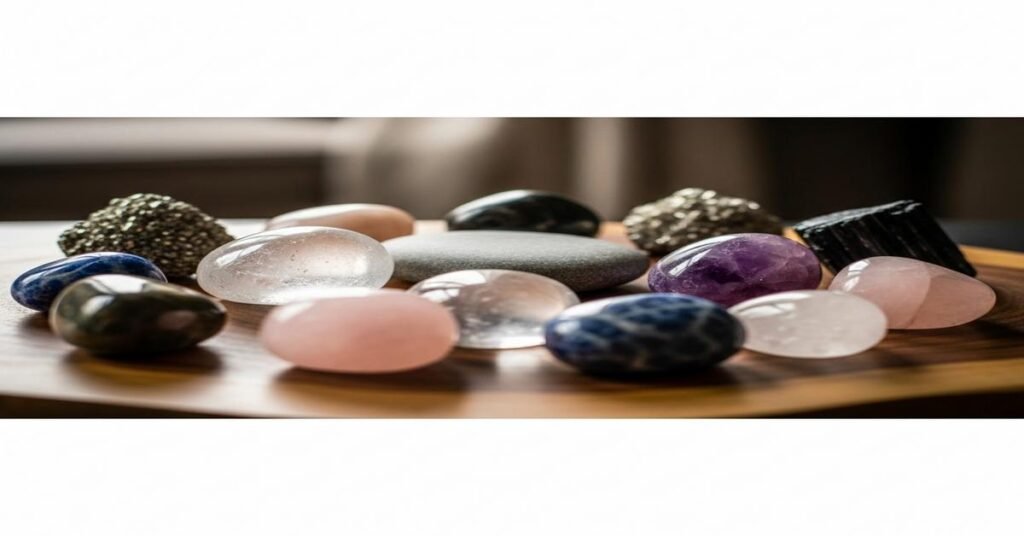Sleeping with crystals is common. Some people keep a ring on all night. Others sleep with a tumbled stone under a pillow. The question is practical: which stones actually pose little risk to your skin, your bedding, or the stone itself — and what does the science say about scratching, chipping, and wear? This article looks beyond folklore. I explain the physical properties that matter, give concrete examples, and offer clear do’s and don’ts so you can sleep safely around your gemstones.
The basic science: hardness, toughness, and cleavage
There are three different properties to keep in mind. Each predicts a different kind of damage.
- Hardness — measured on the Mohs scale. It tells you which materials can scratch which. A mineral with higher Mohs number can scratch one with a lower number. Example: diamond (10) will scratch corundum (9, sapphire/ruby) and quartz (7).
- Toughness — resistance to breaking, chipping, or chipping from a blow. Toughness is not the same as hardness. For example, diamond is extremely hard but can cleave under a sharp impact; some gemstones with lower hardness are actually tougher.
- Cleavage — tendency to split along natural planes. Stones with perfect cleavage (like topaz) can split if pressure hits the right angle.
Why this matters: a high-Mohs stone may not get scratched, but it can chip or create abrasive dust. A softer stone won’t scratch your jewelry but will scuff, lose polish, or catch in fabric.
Which stones are relatively safe to sleep with
“Safe” here means low risk of scratching your skin, tearing sheets, or sustaining damage from typical night-time movement.
- Sapphire and ruby (corundum, Mohs 9): Very hard and tough. A polished 6–8 mm sapphire cabochon or a 1 ct ruby set in a secure bezel or low prong is unlikely to scratch skin or fabrics. Why: high hardness resists abrasion, and good cuts lack sharp projections. Still check prongs regularly.
- Quartz family (amethyst, citrine, rose quartz — Mohs 7): Durable for sleeping if they are polished and set low. A smooth 8 mm amethyst bead has low snag risk. Why: hardness keeps them from being easily abraded, but they can be scratched by harder stones like sapphire or diamond.
- Solid, smooth wedding bands (14k or 18k gold, platinum): A plain, polished band with no raised setting is one of the lowest-risk items to sleep in. Choose 14k gold
Which stones to avoid sleeping with — and why
- Opal (Mohs ~5.5–6.5): Opals are relatively soft and porous. They absorb water and oils and can craze (tiny cracks) or lose their play-of-color. A cabochon opal ring is especially vulnerable when pressure or heat changes occur during sleep.
- Pearls (Mohs 2.5–4.5): Pearls are easily scratched by zippers and even hair clips. Body oils and cosmetics will dull nacre. Don’t sleep with pearl necklaces or pearl-set rings.
- Turquoise, malachite, lapis (Mohs ~3.5–6): These are softer and often porous or treated. They scratch, stain, or get dulled by sweat and lotions.
- Topaz (Mohs 8) and other stones with perfect cleavage: Topaz is hard but has perfect cleavage. A strong sideways pressure during sleep can cause it to split or chip.
- Raw crystal points and sharply faceted stones: Any exposed sharp tip can puncture skin or snag fabric. A raw quartz point under your pillow is a bad idea.
Special concerns: diamond and abrasion
Diamond is the hardest common material (Mohs 10). It resists scratches from everything except other diamonds. But diamond is extremely abrasive. A loose diamond or a ring with multiple diamonds can grind delicate fabrics like silk or satin. Diamonds can also produce microscopic particles when abraded; those can dull nearby softer stones. If you have a diamond solitaire set high (for example, a 1 ct solitaire on tall prongs), it increases the chance of snagging sheets or catching on skin.
Metal considerations and allergies
Jewelry problems at night are not only about the stone. Metal matters. 14k gold18kPlatinum
Practical rules for sleeping with crystals
- Prefer low-profile settings: bezel or flush-set stones are less likely to catch or get hit.
- Remove fragile stones: opal, pearl, turquoise, and any stone with visible cracks should stay off at night.
- If you wear a ring for sentimental reasons, consider a thin silicone ring for sleep. It’s soft and breaks away under heavy force, reducing ring avulsion risk.
- Check prongs and settings monthly. If a stone wobbles or a prong is bent, have a jeweler tighten it before sleeping with it again.
- Avoid sleep positions that put pressure on jewelry — hands under the pillow, face into wrist — to reduce cleavage or fracture risk.
Aftercare if you slept with your jewelry
Wipe stones with a soft cloth to remove oils and sweat. For diamonds, sapphires, and quartz, a mild soap-and-water rinse followed by a gentle brush removes grime. For sensitive stones (pearls, opals, turquoise), wipe with a barely damp cloth and avoid soaking. If you see chips, cracks, or loose stones, stop wearing the piece and take it to a qualified jeweler for inspection.
Bottom line
Whether you can safely sleep with a crystal depends on three things: the stone’s hardness, toughness and cleavage; the setting and metal; and your sleep habits. Durable stones like sapphire and well-set, low-profile pieces are usually fine. Soft, porous, or cleavage-prone gems — pearls, opals, turquoise, topaz — are best removed before bed. When in doubt, remove delicate jewelry. That simple step prevents scratched fabrics, injured skin, and damaged stones.
I am G S Sachin, a gemologist with a Diploma in Polished Diamond Grading from KGK Academy, Jaipur. I love writing about jewelry, gems, and diamonds, and I share simple, honest reviews and easy buying tips on JewellersReviews.com to help you choose pieces you’ll love with confidence.

